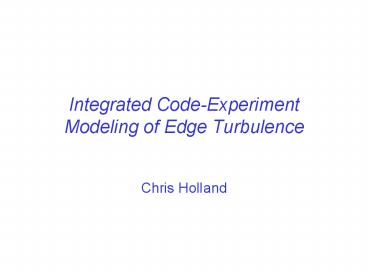Integrated CodeExperiment Modeling of Edge Turbulence - PowerPoint PPT Presentation
1 / 8
Title:
Integrated CodeExperiment Modeling of Edge Turbulence
Description:
PISCES ... PISCES. Initial Modeling of CSDX Uses Simple ... n0 to a source-driven evolving profile, and look for evidence of 'bursty' dynamics / transport ... – PowerPoint PPT presentation
Number of Views:44
Avg rating:3.0/5.0
Title: Integrated CodeExperiment Modeling of Edge Turbulence
1
Integrated Code-Experiment Modeling of Edge
Turbulence
- Chris Holland
2
CSDX Provides Experimental Realization of Edge
Turbulence Suitable for Comparison with Theory
- Benchmarking of edge turbulence models in
tokamaks is complicated by high temperatures,
magnetic geometry, limited shot length, etc. - CSDX provides low-temperature plasma in simple
(i.e. straight) magnetic geometry, which can be
used to verify fundamentals of edge turb. models - Will describe initial efforts to model CSDX
turbulence with a numerical simulation, and some
planned future work
3
Controlled Shear De-Correlation Experiment (CSDX)
CSDX parameter Typical
value Gas pressure
0.5 - few mTorr Electron
Temperature 2.7 eV Ion
Temperature 0.2 eV
(est.) Electron Density 1-10 x
1012 cm-3 Source (Helicon 13.56 Mz source)
1500W (typically) Magnetic Field Strength
Up to 1000 G
29 electromagnet coils surround a stainless steel
column (4 mated sections) in total about 3m long
and 10cm in diameter
1m
Exit Pump
RF source
Multi-tip Langmuir probe can be inserted in
these port
Ar gas is injected here
4
Initial Modeling of CSDX Uses Simple Model for
Density, Potential Fluctuations
- Represents simplest self-consistent edge
turbulence model for studying transport - Model evolves finite kq fluctuations and kq0
potential, but holds axisymmetric density profile
n0 fixed
Definitions
Ion-neutral Collisions Ion Viscosity
Diamagnetic velocity Parallel collisionality
5
Simulation Qualitatively Reproduces Some Observed
Features of CSDX Plasma
(simulation)
Expt. data in black, simulation results in red
RMS density fluctuations
Fluctuating Ar emission (expt.)
Background density n0
RMS Vfloat and Vplasma fluctuations
6
Simulation Predicts Nonlinear Generation of Mean
Azimuthal Shear Flow, Also Observed in Experiment
- Spontaneous shear
- flow formation is
- believed to be the
- underlying physics
- mechanism of the
- L-H transition
- This work will be
- discussed in more
- detail by J. Yu on
- Wednesday
7
Simulation Does Not Exhibit Bursty Behavior Seen
in Experiment
(simulation)
Possible source of difference code assumes
steady n0
8
Future Directions
- Transition from investigation of general basic
physics questions to more edge-specific issues - Specific goal identify mechanisms of blob
formation in linear plasma devices - First step transition from fixed n0 to a
source-driven evolving profile, and look for
evidence of bursty dynamics / transport - Second Step add passive impurity tracer to study
entrainment/inflow in presence of bursty transport































